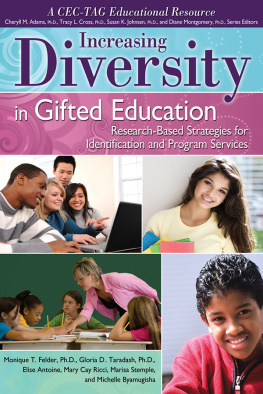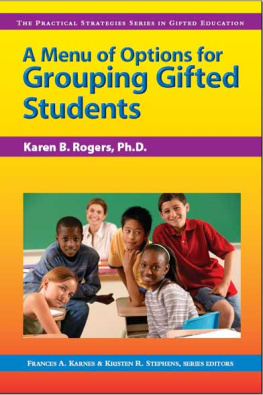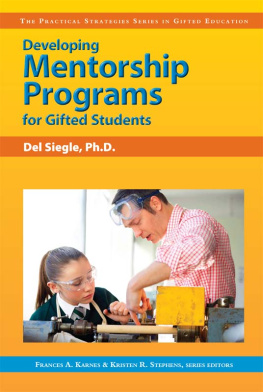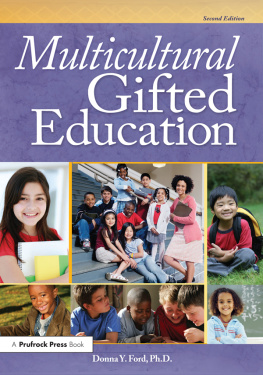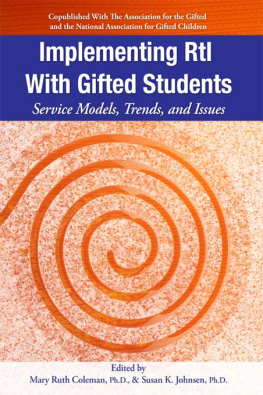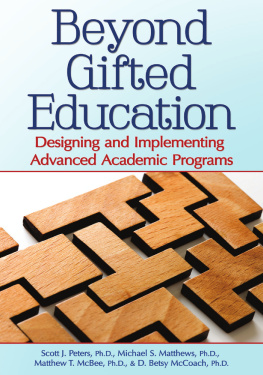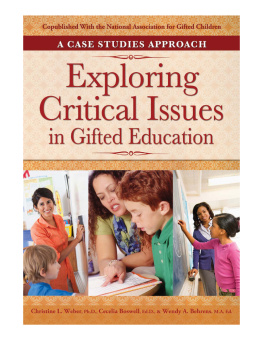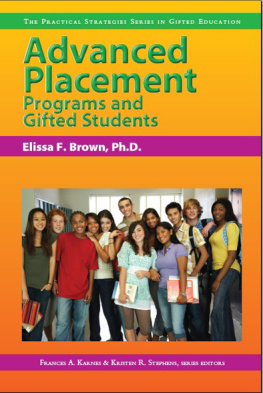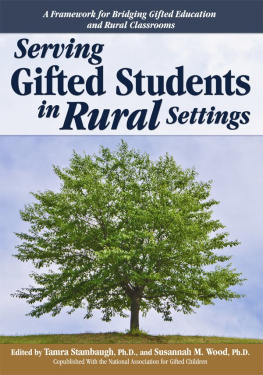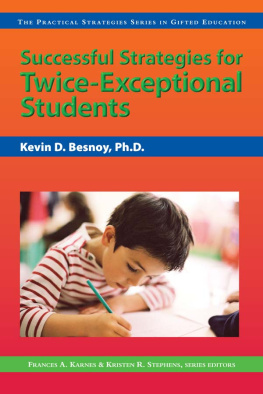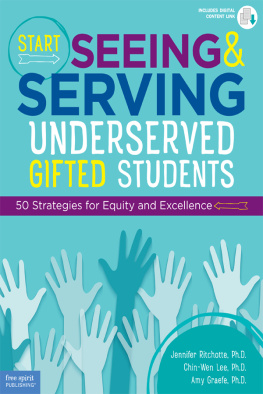

Copyright 2015 Prufrock Press Inc.
Edited by Lacy Compton
Cover and layout design by Raquel Trevino
ISBN-13: 978-1-61821-272-6
No part of this book may be reproduced, translated, stored in a retrieval system, or transmitted, in any form or by any means, electronic, mechanical, photocopying, microfilming, recording, or otherwise, without written permission from the publisher.
At the time of this books publication, all facts and figures cited are the most current available. All telephone numbers, addresses, and websites URLs are accurate and active. All publications, organizations, websites, and other resources exist as described in the book, and all have been verified. The authors and Prufrock Press Inc. make no warranty or guarantee concerning the information and materials given out by organizations or content found at websites, and we are not responsible for any changes that occur after this books publication. If you find an error, please contact Prufrock Press Inc.

| Prufrock Press Inc.
P.O. Box 8813
Waco, TX 76714-8813
Phone: (800) 998-2208
Fax: (800) 240-0333
http://www.prufrock.com |
Table of Contents
Introduction
Demographics are quickly changing across the United States. According to the 2010 Census (Mackun, Wilson, & Fischetti, 2011), the population of the United States increased from 281.4 million people to 308.7 million people in the last decade. The overwhelming majority of the 27.3 million population increase represents non-White races/ethnicities. Not surprisingly, the Brookings Institution reported that a multiethnic minority student population will continue to pour into Americas elementary, middle, and high schools in the coming decades and most likely will become the majority by 2043 (Frey, 2011). The leaders of the 21st century are embodied in that population of culturally, linguistically, and/or ethnically diverse (CLED) students who are rapidly increasing in American public schools; leaders of the 21st century are also embodied in the population of learning disabled students in our public schools. Individuals with exceptional potential, who have been provided with the opportunity to maximize their potential, have made significant contributions to all aspects of American society. This potential is most often cultivated and supported in programs and services for the gifted. However, nationwide, gifted students who are CLED and/or have a disability are systematically underrepresented in programs and services for the gifted (National Association for Gifted Children [NAGC] & Council of State Directors of Programs for the Gifted [CSDPG], 2011). Ford (2014a) used the Relative Difference in Composition Index to statistically analyze the underrepresentation of African Americans and Hispanics in gifted education. She found that as of 2009 and 2011, at least half a million African American and Hispanic students combined were not identified as gifted.
As the field of gifted education considers Americas changing demographics and future, the continuing underrepresentation of CLED and twice-exceptional students receiving educational services for the gifted and talented must be addressed. The Association for the Gifted (TAG), a division of the Council for Exceptional Children, embraces diversity as the foundation for developing effective practices to identify and serve children of potential equitably. To that end, TAG developed the document, Diversity and Developing Gifts and Talents: A National Call to Action (2009). This document demands a radical change in the way the field of education views and serves gifted children who are culturally, linguistically, and ethnically diverse; who are raised in poverty; who are of diverse sexual orientation; and who are twice-exceptional. The precepts in this document support the actions of TAG.
Gifted education in the 21st century embodies the ideal that the capacity for exceptional achievement exists across all racial, ethnic, language, and economic groups as well as some categories of disability (TAG, 2009). Understanding that ideas of capability change as society evolves, how do we, as practitioners and professional development personnel, answer the call to action? Can we recognize the hints and clues of potential in CLED students as well as students in categories of disability such as those who are twice exceptional? What do we need to know and do to educate diverse and twice-exceptional children at the edge of their ability?
Ford (2010, 2014b) submitted that as professionals prepare to equitably educate culturally different gifted students, that preparation must be grounded in understanding how to create culturally responsive classrooms. Included in that preparation is a critical analysis and professional response to the following three issues (Ford, 2010):
- Deficit thinking: Thinking grounded in the belief that culturally different students are genetically and culturally inferior to White students. A belief that their culturebeliefs, values, language, practices, customs, traditions, and moreare substandard, abnormal, and unacceptable.
- Colorblindness (culture-blindness): Intentionally or unintentionally suppressing the importance of and role of culture in learning, curriculum, instruction, assessment, and expectations. A presentation of fairness by not seeing differences and treating everyone the same.
- White privilege: Unearned benefits that advantage Whites while disadvantaging others. A form of entitlement and affirmative action in which the social and cultural capital of White Americans is valued and held as normal, normative, or the standard, conferring dominance to one group ().
This book begins with an overview of issues related to the identification of CLED populations as gifted and talented in to learn more about this group of students. Additionally, each chapter on CLED as well as the chapter on twice-exceptional students follows the same format:
- characteristics;
- obstacles to gifted identification;
- best practices for gifted identification;
- concluding remarks; and
- references.
.
Although the length of each chapter varies, some information overlaps across chapters, and information on addressing the challenges impacting the identification of a gifted CLED population found in one chapter (i.e., : Gifted African American Learners), it is important to note that this book was not intended to be all-inclusive or exhaustive. As our reference lists indicate, there is a wealth of additional information available in the field regarding the topics addressed in each chapter of this book. We encourage you to go beyond the pages of this book in your quest to increase your knowledge and understanding about CLED gifted and twice-exceptional students. Our goal was simpleto provide busy educators with the most salient information about each of the CLED populations and twice-exceptional learners discussed in this book. It is our sincere desire that the books format is found to be practitioner-friendly and that this book provides practitioners with the information and knowledge needed to increase the identification of CLED and twice-exceptional students for gifted education programs and provide services that address their needs.

